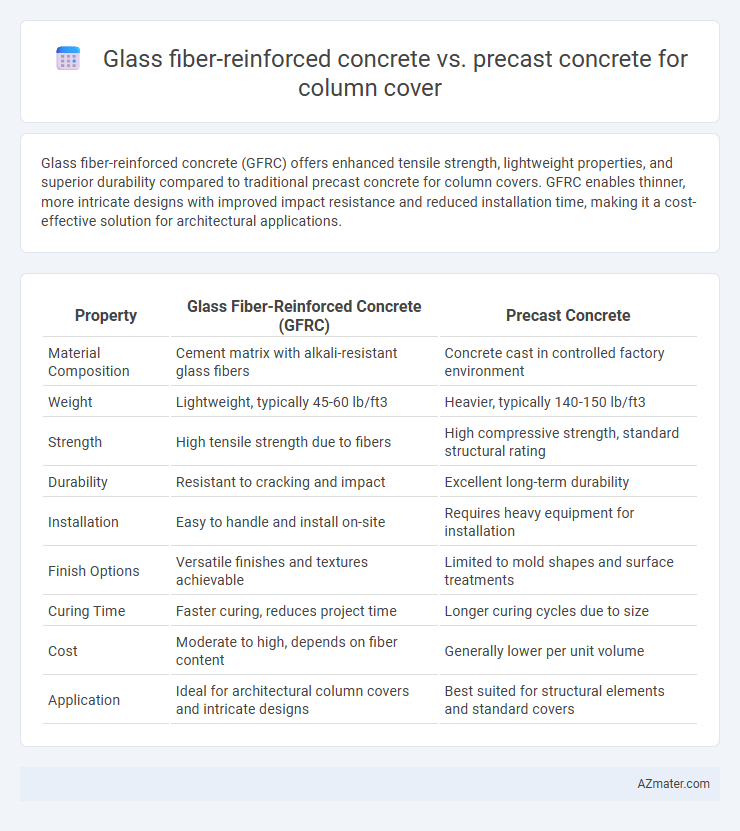Glass fiber-reinforced concrete (GFRC) offers enhanced tensile strength, lightweight properties, and superior durability compared to traditional precast concrete for column covers. GFRC enables thinner, more intricate designs with improved impact resistance and reduced installation time, making it a cost-effective solution for architectural applications.
Table of Comparison
| Property | Glass Fiber-Reinforced Concrete (GFRC) | Precast Concrete |
|---|---|---|
| Material Composition | Cement matrix with alkali-resistant glass fibers | Concrete cast in controlled factory environment |
| Weight | Lightweight, typically 45-60 lb/ft3 | Heavier, typically 140-150 lb/ft3 |
| Strength | High tensile strength due to fibers | High compressive strength, standard structural rating |
| Durability | Resistant to cracking and impact | Excellent long-term durability |
| Installation | Easy to handle and install on-site | Requires heavy equipment for installation |
| Finish Options | Versatile finishes and textures achievable | Limited to mold shapes and surface treatments |
| Curing Time | Faster curing, reduces project time | Longer curing cycles due to size |
| Cost | Moderate to high, depends on fiber content | Generally lower per unit volume |
| Application | Ideal for architectural column covers and intricate designs | Best suited for structural elements and standard covers |
Introduction to Column Cover Solutions
Glass fiber-reinforced concrete (GFRC) offers superior tensile strength, lightweight properties, and enhanced durability compared to traditional precast concrete, making it an ideal solution for column covers requiring intricate designs and reduced weight. Precast concrete remains a cost-effective and robust option for large-scale applications, providing excellent compressive strength and consistent quality through factory-controlled conditions. Choosing between GFRC and precast concrete depends on project-specific demands such as design complexity, weight constraints, and aesthetics for column cover solutions.
Understanding Glass Fiber-Reinforced Concrete (GFRC)
Glass fiber-reinforced concrete (GFRC) offers superior tensile strength and lightweight properties compared to traditional precast concrete, making it an excellent choice for column covers. GFRC consists of a cementitious matrix embedded with alkali-resistant glass fibers, enhancing durability and resistance to cracking and impact. Its flexibility allows for intricate designs and faster installation, providing both aesthetic and structural advantages over heavier precast concrete options.
What is Precast Concrete?
Precast concrete is a construction material produced by casting concrete in a reusable mold or form, which is then cured in a controlled factory environment before being transported to the construction site. This method ensures high strength, uniformity, and durability, making it ideal for column covers that require precise dimensions and consistent quality. Compared to glass fiber-reinforced concrete, precast concrete offers faster installation and reduced on-site labor, contributing to overall project efficiency.
Key Material Properties: GFRC vs Precast Concrete
Glass fiber-reinforced concrete (GFRC) offers enhanced tensile strength and superior durability due to its non-corrosive glass fibers, making it highly resistant to cracking and impact compared to traditional precast concrete. GFRC is lightweight, allowing for easier handling and installation, whereas precast concrete is denser and heavier, providing higher compressive strength but less flexibility. The porous nature of precast concrete can lead to moisture absorption and potential freeze-thaw damage, while GFRC's reduced permeability improves longevity in harsh environmental conditions.
Design Flexibility and Architectural Options
Glass fiber-reinforced concrete (GFRC) offers superior design flexibility and extensive architectural options for column covers due to its ability to be molded into intricate shapes and detailed textures with thinner profiles. Precast concrete, while providing robust structural strength and faster installation, typically limits architectural variation because of standardized casting molds and heavier, bulkier sections. GFRC's lightweight composition allows for creative facade applications and complex geometries that enhance aesthetic appeal without compromising durability.
Installation Methods and Construction Speed
Glass fiber-reinforced concrete (GFRC) column covers are typically installed using lightweight, modular panels that can be quickly attached to steel or concrete frames, minimizing the need for heavy lifting equipment and allowing faster on-site assembly. Precast concrete column covers require transportation of heavier, monolithic units and often need cranes for precise placement, which can extend installation time and logistical complexity. GFRC's faster installation process and reduced weight contribute to accelerated construction schedules compared to the bulkier and heavier precast concrete alternatives.
Durability and Maintenance Requirements
Glass fiber-reinforced concrete (GFRC) offers superior resistance to cracking, corrosion, and environmental stress compared to traditional precast concrete, making it highly durable for column covers in harsh conditions. GFRC requires minimal maintenance due to its lightweight and non-corrosive fibers, while precast concrete may need periodic sealing and repairs to address surface wear and potential spalling. The enhanced durability of GFRC significantly reduces long-term maintenance costs and extends the service life of column coverings.
Cost Comparison: GFRC vs Precast Concrete
Glass fiber-reinforced concrete (GFRC) offers a cost-effective solution for column covers due to lower material and transportation expenses compared to precast concrete, which often requires more extensive mold fabrication and curing time. GFRC's lightweight nature reduces installation labor costs, while precast concrete's heavier weight can increase handling and crane usage expenses on-site. Overall, GFRC provides a more economical option for projects prioritizing budget efficiency and faster installation times in column cover applications.
Sustainability and Environmental Impact
Glass fiber-reinforced concrete (GFRC) offers enhanced sustainability through its lightweight composition, reducing transportation emissions and lowering material consumption compared to traditional precast concrete used for column covers. GFRC utilizes recycled glass fibers, which contributes to waste reduction and decreases the carbon footprint associated with raw material extraction. Precast concrete, while durable, often involves higher energy-intensive manufacturing and longer curing times, resulting in an increased environmental impact relative to the eco-friendly benefits of GFRC alternatives.
Choosing the Right Column Cover Material
Glass fiber-reinforced concrete (GFRC) offers superior tensile strength, lightweight properties, and enhanced durability against environmental factors, making it ideal for complex shapes and decorative column covers. Precast concrete provides high compressive strength, rapid installation, and cost-efficiency for standard column designs where load-bearing capacity is critical. Selecting the right column cover material depends on structural requirements, aesthetic preferences, and environmental exposure conditions to ensure long-term performance and maintenance efficiency.

Infographic: Glass fiber-reinforced concrete vs Precast concrete for Column cover
 azmater.com
azmater.com